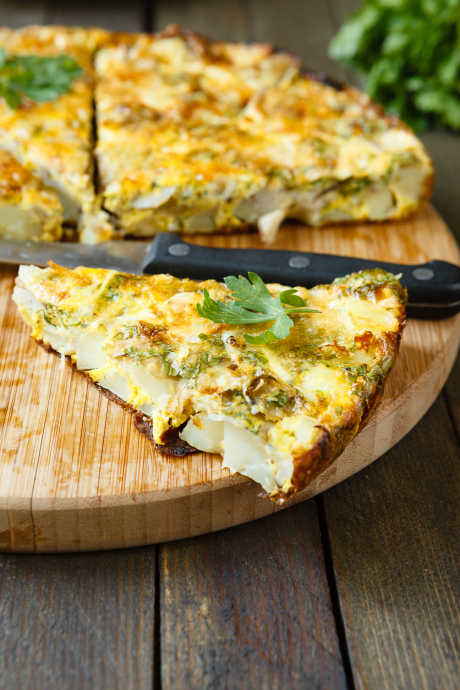Frittatas Turn Leftovers Into Lunch
Posted by Julie on Aug 16th 2019
We’re big fans of easy recipes that come together quickly using ingredients we have on hand. We love such recipes even more when they help us use up leftovers. Frittatas hit the mark perfectly. This simple egg-based dish is a smart one to have in your repertoire. We’ll cover the differences between frittatas, quiches, and omelets, as well as five key steps to follow when making a frittata. Get out the eggs, and let’s get started.
Frittata vs. Quiche vs. Omelet: What’s the Difference?
We turned to The Kitchn to help us sort out the specifics of frittatas, quiches, and omelets. While they’re all egg-based, one difference concerns the amount of dairy added to the eggs. A quiche contains a greater proportion of dairy than eggs. The custard is creamy, but not so liquid that it won’t set. A frittata contains some full-fat dairy, often in a solid form like sour cream or yogurt. An omelet contains no dairy at all.

There are other differences involving ingredients, cooking method, and cookware used. In both a frittata and a quiche, the fillings are combined with the egg mixture. In an omelet, the fillings are folded into the center of the cooked eggs. A quiche is baked in a crust, while neither a frittata nor an omelet has a crust. Quiche is baked in a pie dish, while an omelet is cooked in a skillet on the stovetop. A frittata starts in a skillet on the stovetop, but is then transferred to the oven.
Why Should You Make a Frittata?
One of the best reasons to make a frittata is to use up leftovers. Got some extra steamed or sauteed vegetables? How about last night’s grilled chicken or browned sausage? Potatoes and onions are also great additions to a frittata. Because you don’t have to follow a specific recipe, simply use what you have on hand. Frittatas also keep well and make great packed lunches. Clean out the refrigerator on Sunday, whip up a frittata with everything you find, and slice it up for breakfast and lunch during the coming week.
Five Key Steps to a Frittata
1. Pick a Pan
Frittatas start on the stovetop and finish in the oven, so you’ll need a pan that can do both. Bon Appetit recommends a well-seasoned cast iron pan, while Self opts for a nonstick pan. Cast iron is definitely oven-safe, while nonstick pans aren’t always meant to withstand the high heat of the oven. Check yours before using it this way.
Either way, Bon Appetit cautions you to keep heat retention in mind. A cast iron pan may take a while to heat up, but it holds onto heat well. That means the contents will keep cooking even after you take it off the burner or out of the oven. Factor this into your cooking time.
2. Use Full-Fat Dairy
In a quiche, dairy makes up a good proportion of the volume. The filling can be more liquid because it’s surrounded by crust. In a frittata, there’s no crust to hold the filling. The dairy adds moisture and creaminess to a frittata. That’s why it ought to be full-fat, and preferably in a solid form like sour cream, yogurt, or creme fraiche. Heavy cream will also work, or whole milk in a pinch, but don’t use low-fat or skim milk. Those varieties are too watery.
3. Prepare Your Egg Mixture
The egg mixture for a frittata includes dairy, cheese, and eggs, of course. Bon Appetit recommends a half-cup of dairy per dozen eggs, which is the usual number of eggs in a single frittata. Make sure to stock up! Beat the eggs and blend them with sour cream or yogurt before seasoning generously with salt and pepper. Then stir in a cup of cheese. Choose a combination of cheeses that melt easily. Bon Appetit has a whole list of cheeses that are known for melting. We’d forego American cheese in a frittata, but gruyere and fontina are at the top of our list.

4. Pre-Cook Meat and Vegetables
Remember how we said frittatas are great for using up leftovers? That’s because those fillings need to be pre-cooked. Using leftovers eliminates this step. However, you can still use fresh ingredients, but you’ll need to cook them first. The cooking time and temperature for a frittata isn’t sufficient to cook raw meat. Vegetables and aromatics should also be pre-cooked to dry them out and prevent them from watering down your frittata. The good news is you can saute them in the same pan you’ll use to cook your frittata.
5. Keep an Eye on the Cooking Time
Frittatas start on the stovetop, but when the edges are set, you should transfer it to the oven. Some recipes will call for cooking a frittata entirely on the stovetop, which means you’ll need to flip it. Instead, we prefer to finish it in the oven and check it frequently. Bon Appetit specifies that a frittata is ready when the center is barely set.
Still not quite ready to wing it with a frittata on your own? We love this frittata formula from Extra Crispy, with helpful instructions for how and when to cook and combine ingredients, as well as rough guidelines for quantities. The one change we’d make is to eliminate the broil time, or start it a little sooner. Because a cast iron pan retains heat so well, you can overcook your frittata even as it cools on the stovetop. We would take it out while it’s still wobbly and let it finish cooking outside the oven.
 Free shipping over $49
Free shipping over $49










